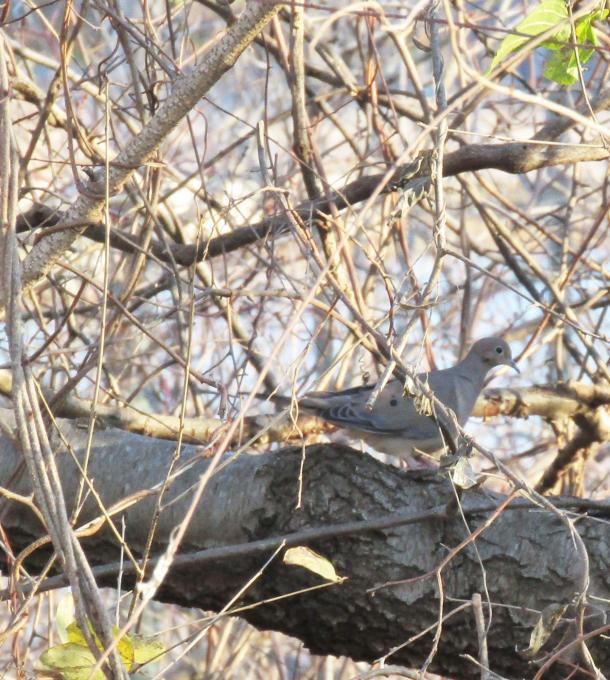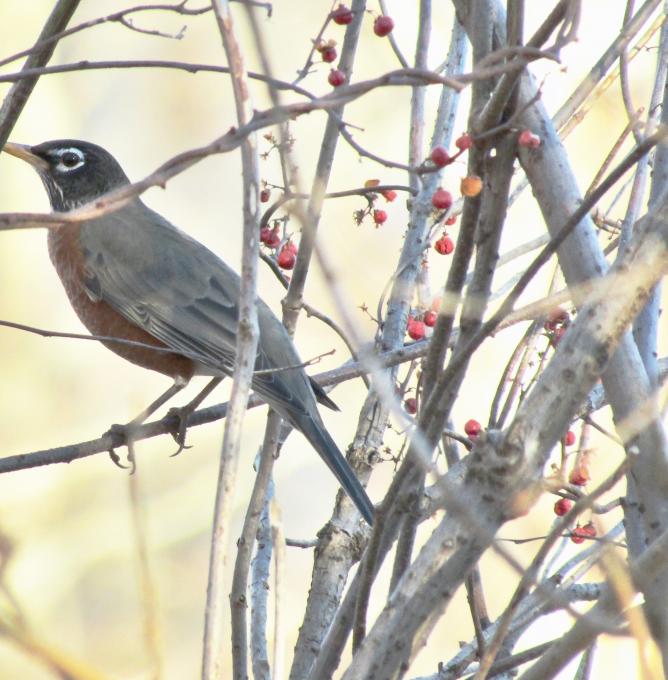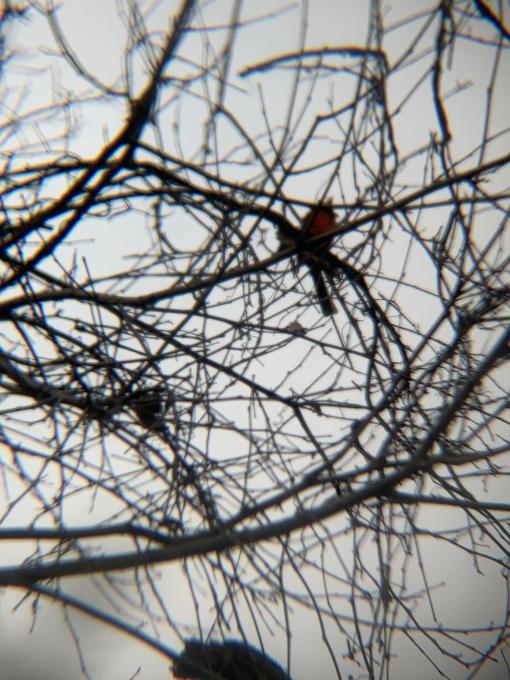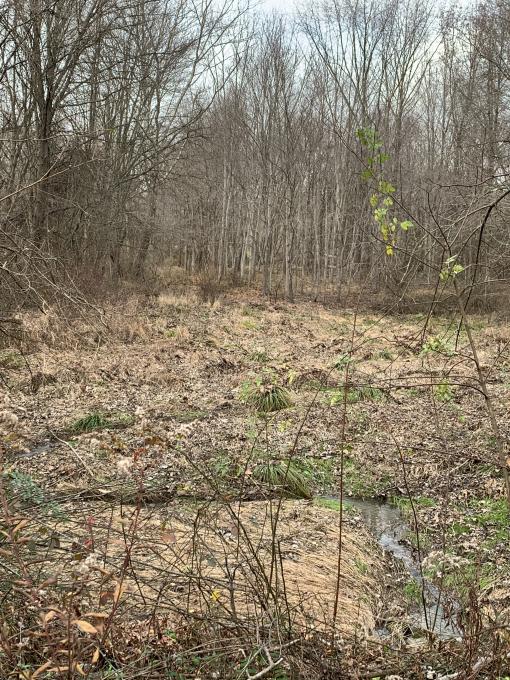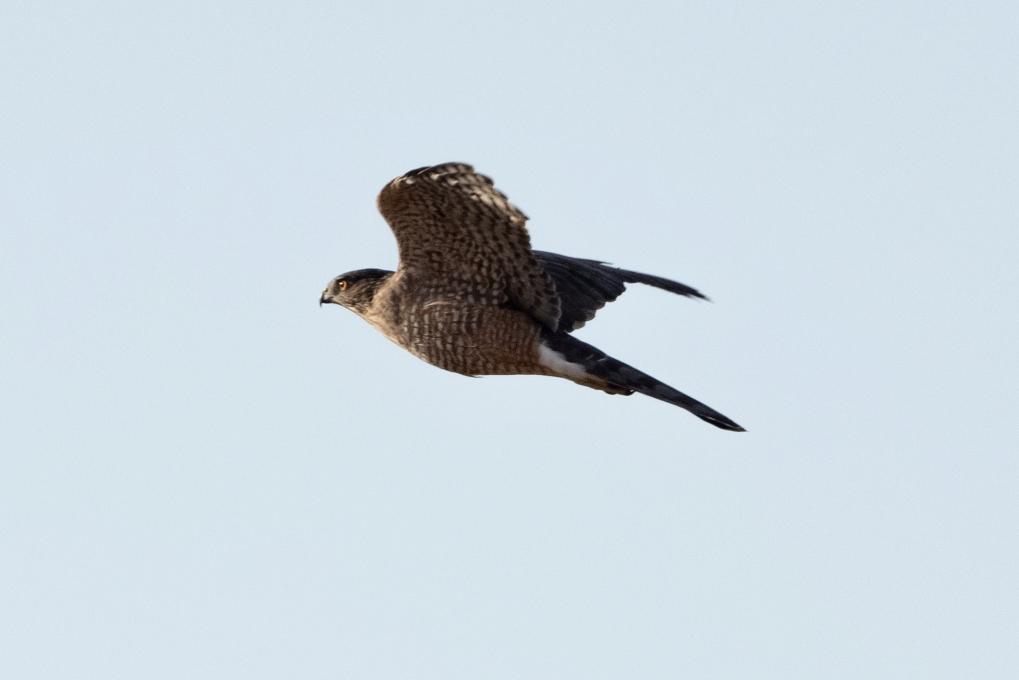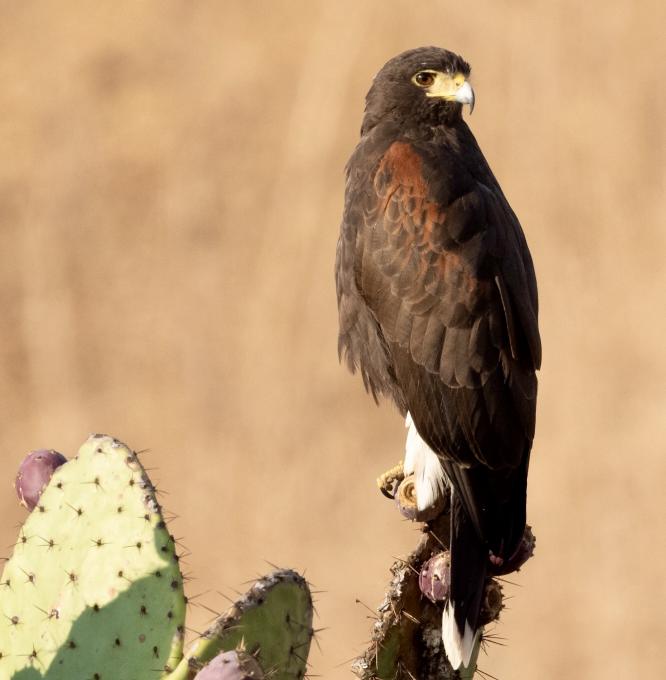The Cornell Lab Bird Academy › Discussion Groups › Joy of Birdwatching › Activities: Exploring Bird Habitats
-
One of my favorite places to go birding is along a 3.5 mile fitness trail at Camp Murray, a National Guard Camp that sits on American Lake near Tacoma Washington. Along the lakefront portion of the trail I observe a lot of seabirds and duck species and as I reach the inland part of the trail the mix turns into finches, hummingbirds, sparrows, and juncos. Even with the range maps and recommendations from Merlin, I am still hesitant to confirm an observation until I know beyond a shadow of a doubt what the species is. The reason for this is climate change related. Over the last few years, our winter weather patterns in Western Washington have changed (the couple of years prior to this one, Mount Rainier was turning brown during the summer as the ever present snow was melting and Mount Saint Helens had very little). Have any studies been done on how climate change is impacting habitat and the migratory patterns?
-
Roger Road is located in an urban setting, near the Santa Cruz River and Sweetwater Wetlands Park. As a result, there are many species of waterfowl recorded for the area, as well as many song birds. There are a number of suburban areas nearby with trees associated with houses; there also appear to be sewage processing holding ponds in the area. Actually, the landscape looks totally unnatural. The other locale, Mt. Lemmon, is located in a forested, natural habitat. The bird lists contain many songbirds, predatory birds, and a variety of woodpeckers.
-
On the lake where I live there are so many different species of birds. In the water, mallard ducks, tundra swans, buffleheads and mergansers are common waterfowl today. Along the shore bonaparte's gulls, herring gulls, ring-billed gulls and sandhill cranes forage for food. For the first time, I am noticing the different methods they use to obtain food and how they survive together in this habitat. In the nearby forest, I can see bluejays, many varieties of sparrows, nuthatches and chickadees. I was looking for pileated woodpecker to observe their foraging but was not able to locate one. On my bucket list.
-
In my community, I can walk to a variety of habitats--deciduous forest, some more open areas, and a pond surrounded by both pine groves and deciduous forest. Unfortunately, the homeowner's association mows the common areas, including around the large pond, as if the areas were part of a golf course--i.e., mowing goes right to the pond's edge, leaving little room for natural growth to act as cover. In open areas, vegetation is mowed as if it were part of a suburban front lawn. More willingness to allow for natural, unmanicured growth would increase species diversity. Regardless of that issue, each habitat in the community has its unique inhabitants. By the pine forests, I can find Ruby- and Golden-Crowned Kinglets; at the pond, I see Great Blue Herons and sometimes Green Herons, and in the winter months, we're graced with Buffleheads, Hooded Mergansers, Mallards, and an occasional group of Ring-Necked Ducks. Brushy areas on the back of the dam of the main pond create habitat for White-Throated and Song Sparrows, and Lincoln Sparrows during migration, along with Carolina and Winter Wrens. Thrushes and Waterthrushes appear by the stream in spring and summer. The ubiquitous Chickadees, Blue Jays, Cardinals, Tufted Titmouses (mice?), White-Throated Sparrows and crows (American and Fish) can be seen year round in many of these locations.
-
:) I like birds. I’ve seen European Starlings, American Crows, American Robins and Blackbirds near me in Arlington, VA.
-
Our suburban neighborhood is largely arboreal with many large, mature trees such as oaks and sycamores. They attract woodpeckers, blue jays, nuthatches. Yards are planted with hedgerows and bushes that shelter sparrows, wrens, finches and titmice. There are also nearby parks with ponds and streams that attract redwing blackbirds and mallards. The Roger Road refuge is clearly home to a wide variety of water fowl and arboreal inhabitants. It must be a large and diverse ecosystem, perhaps with woods in close proximity to a large body of water. Doesn't seem to attract species that prefer open habitat. Mt. Lemmon, on the other hand, has hardly any waterfowl, and seems to combine forest and open areas based on the species sighted.
-
I chose the two AZ spots, being a graduate of the University of AZ... Clearly Roger Road is near water, since there are so many species of ducks and other waterfowl. But there are also many sightings of species like flycatchers, warblers, kinglets and wrens that require some understory so I imagine it being a brushy type habitat with some desert trees. Mt. Lemmon has more birds of prey, woodpeckers, and, and owls that might require suitable trees for food and homes. The top of Mt. Lemmon is a much hire elevation and vegetation is so different than at its base - but maybe that is cheating!
-
Not cheating!! Elevation includes changes in climate, which means changes in vegetation and the birds and animals that live there. Good observation.
-
I am a U of A graduate, too, so I looked at this and was rather nostalgic. I wish they had use Sabino Canyon as another contrast spot nearby--my favorite natural place in the area. It is pretty incredible how much variation you can find in close proximity.
-
-
I would guess, the first place, ROGER ROAD, is near, or on some water. There are many more ducks, and forms of ducks, listed on the list. There must be some shrubs, and bushes. Because there are a lot of birds that need cover, and are perching birds , or tree foragers. MT. LEMMON, seems to have no waterfowl. And a lot of raptors, or birds that are not 'home dependent' on a watery home. The birds listed are perchers ? Or tree foragers, and must be birds that are not living in, or on, or near water. No, or little waterfowl listed. My guess.???????????????????????????????????????????????????????????????????


-
ACTIVITY 1 - There is a cemetery, that always has the same group of birds. Blue Jays, Geese, Robins, and Swans. It is located in an urban area, in WALTHAM MA. It has the same exact birds, the 2-3 times I have been there. The river, has Swans. Swimming by. The bushes, have birds, that live in the berried trees, by the river. And there are always Blue Jays, and Geese, in the cemetery as well. In Concord Ma., there is a wildlife reservation, with a lot of more wild, less urban birds. Ospreys, Blue Heron, Red-Winged BlackBirds, and even non-birds, muskrats, and turtles. There seems, to be, an appreciation of nature, here. There is less man made landscapes, IN this area. And it is more inviting to wilder birds. I have seen Swans here, and Geese. But no Blue Herons' in Waltham.

-
1. An area where I go birding is an island in a river, it has woodland areas where I see kinglets, chickadees, in some sections Ive seen waxwings and flickers, then when you round the trail it opens up on a beach where Ive seen wintering sandhill cranes, geese, cormorants, and plovers. 2. While there are some birds in both locations in Arizona, like kinglets and finches, there appear to be zero water birds in the Mt. Lemmon area leading me to believe that this area is more forested or lowland forest like, where as the Roger Road obviously has some water near by for their to be so many waterfowl sighted, it does not appear there is water at this location in summer just in the winter months.
-
I have found a lot of birding spots in My neighborhood. There is a large forest that has trails through it that goes near a river and marsh, and an excellent field with a small creek running through it where I have seen sparrows, hawks, chickadees, warblers, and multiple owls.


-
Two different areas where I go birding are a coastal location and one further into the mountains. There are many similarities in regards to passerine species, but there are many more shorebirds and wading birds at the coastal location. However, I think that the ponds and lakes at the more mountainous location attract a number of waterfowl. For the second activity, I chose the Arizona locations. Given the number of waterfowl, shorebirds and seabirds, as well as a range of passerines like warblers seen at Roger's road, I expected it to be a region with a body of water, lots of trees, and close to the ocean. The backgrounds of the photos confirmed my theories of trees and water, but looking at a the eBird hotspot map disproved my idea of it being anywhere close to the ocean. However, then where did the sightings of gulls, cormorants and a pelican come from? Looking at the comments on some of the sightings, it seems that many of them were very rare and seen in flight. For Mt. Lemmon, given the fact that it is presumably a mountain, as well as the much reduced numbers of water-dwelling birds and increased numbers of birds that one would associate with a shrubby mountainous environment, like many birds of prey, sparrows and other small passerines, I expected it to be mountainous terrain. Looking at the photos attached to various checklists, it does look like it is a mountainous region, although with more large trees than I had expected.
-
Activity 1: In my suburban backyard, I have observed house sparrows, cardinals, robins, blue jays, goldfinches, pine siskins, crows, red bellied woodpeckers, house finches, Carolina wrens, dark eyed juncos, and cedar waxwings at various times of the year. Just south of my home is a park with a creek running through it, a restored prairie with various tall grasses, and an open area where people fly kites. In the open area, a red tailed hawk caught something on the ground and ate it. On the trail through the tall prairie grass, I ran into a male ringed neck pheasant which also hangs out in the shrubs along a fenced area near the park. We have nest boxes for tree swallows at this same park and we get to watch their aerial acrobatics in the spring. Of course, we also have plenty of red winged blackbirds who nest along the creek and sing during the summer. Mallards also visit this same creek. Many of my backyard birds such as the robins and sparrows are easy to spot at the park, too, but the red winged blackbirds stay near the water along with the ducks.
-
Activity 2: I chose to review the species reported on eBird Checklists at Roger Road and Mt Lemmon in Arizona for this exercise. At Roger Road, I am guessing this is a lowland - wetland habitat as ducks, grebes, Coots, Egrets were observed. Also birds that prefer to be near the edge of water with some trees like woodpeckers and hawks, and low brush or high grass like sparrows and flycatchers. At Mt. Lemmon - ravens, jays, nuthatch, woodpeckers, wrens, bluebirds, thrush, crossbill and warblers were observed. I am guessing that this is not a water habitat, but a mountainous habitat with trees and low brush were these species can forage and hide from predators.
-
Activity 1. I have some settling ponds that are down by the Harbor and an estuary of a small river that does not flow year round. Even though these two locations are only a mile or so apart both areas have habitats quite different. When I am at the estuary, I am likely to see a lot of shore birds like Willets, Sanderlings, Marbled Godwits, Long-billed Curlews, Sandpipers, several Gulls, Brown Pelicans, and during breeding with luck Snowy Plovers and Least Terns. The settling ponds have lots of waterfowl like Mallards, Gadwalls, Ruddy Ducks, Canadian Goose as well as a wide variety of migrant birds. Western Grebes, Eared grebes, Pied-billed Grebes, Clark’s Grebes, and American Coots are often sited. There are Great Blue Heron, Black-crowned Night-Heron, Great Egrets, and Snowy Egrets year round. There are lots of scrubs and bushy trees so that brings Tree Swallow, Belted Kingfisher, Black Phoebe, Say’s Phoebe, House Sparrows, Song Sparrows, American Goldfinch, Brewer’s Blackbirds, Red-winged Blackbirds, and Great-tails Grackle. I am amazed at how close physically two habits can be and some birds will be visible in both, but mostly the food for the different species seem keep them apart. Activity 2. I checked out the Arizona hotspots for Roger Road and the species list had a large amount of water fowl and birds that marshy areas, I would expect to see a pond or lake with bushes and trees. I also saw smaller numbers in migrating birds. I looked up the location and my guess was right on. I checked out the Mr. Lemmon and with the number of mountain birds, birds of prey, and species that like mountain elevations, I expected wilderness with Conifer and Pine trees. I looked up the location and was two for two. Pat
-
1. Silver Springs at the river: Anhinga, cormorants, kingfisher, red shouldered hawk, great blue heron, tricolor heron, and osprey are often seen. In the same park but on the Sandhill Trail there are scrub jays, red headed woodpeckers, quail, red-bellied woodpeckers, towhees, chickadees, and various warblers at different times of the year. Four miles apart and totally different habitats and birds. 2. Down House: seems like it would have woods (woodpeckers) meadows (larks) and not far from bodies of water (various gulls). Sevenoaks must have large freshwater body of water to account for all the ducks, swans, geese with wooded area nearby.
-
Activity 1: For my first habitat that I visited I went to a lake. There I saw the usual things I would expect to see, primarily water birds such as, Great Blue Heron, Great Egret, Little Blue Heron, Wood Ducks, Double-crested Cormorants, Anhingas, Black-bellied Whistling Ducks, Common Gallinule, White Ibis, Limpkin, and Belted Kingfishers. The pond is surrounded by a paved side walk and then wooded area and swampy land so there are multiple habitats in the area. I saw quite a few other birds that are not so dependant on the water, like Eastern Phoebes, Northern Flickers, Pileated Woodpecker, House Wrens, Carolina Wrens, Northern Cardinals, Blue-gray Gnatcatchers, Northern Mockingbird, and a Red-shouldered Hawk. For my second habitat I went to an open field that had been recently mowed. It has wooded area around it and is near a small lake. Focusing on only the open field area I saw lots of Palm Warblers, Northern Cardinals, House Finches, Blue Jays, Carolina Chickadees, White-eyed Vireos, Tufted Titmouse, Brown Thrasher, and Northern Mockingbird. Since I do a lot of birding and visiting various birding hotspots in my area, the findings in each of these areas where not a surprise to me. As you can see, there are some birds that can be found in both areas since the water being present does not deter the birds who like to be in wooded areas or open hunting area. However, you will not typically find the water birds where there is not water, with exception to flyovers. Activity 2: I enjoyed looking at and comparing the hotspots both in Arizona and in England. Much like my own habitat comparisons one was a habitat with water and one without. I could see that the results had similarities to my own results in that, there were water birds at the locations with water but also other birds that can be found in habitats without water. All areas had some birds in common that were non-water birds.
-
Activity 1: Since I've started birding, I've mainly visited a local hotspot that has a couple ponds with some shrubs and a few trees. I always see the usual group of Mallards in the ponds, and sparrows among the shrubs. According to Merlin ID, one of the most common types of birds in my area is the Woodhouse Scrub Jay, but I had yet to see one. I decided to try a different hotspot near me that is more forested than the ponds and shrubs I've spent most of my birding time in. Well, I immediately saw about five Woodhouse Scrub Jays at the more forested spot. I also saw a Brown Creeper and a White-breasted Nuthatch that got added to my life list. I was happy to have the experience of finding different habitats that are still so near. Activity 2: Looking at the species list for Roger Road WRF, there are some waterfowl listed (Mallard, American Wigeon). There must be some body of water at that location. Mt. Lemmon's species list lacks any waterfowl, but lists hummingbirds, flycatchers, and warblers. I would guess Mt. Lemmon is a high desert habitat with scrubby shrubs.
-
Activity 1 : Yesterday I went birding on Randall's Island here in NYC. I visited 3 spots on the Island. The first spot, known as Little Hellgate, was a small salt marsh with some some minimal trees that run alongside the water. In this area I watched yellow rumped warblers flying around in branches chasing insects, pine siskins and house finches perched in the top of the trees, a juvenile black crowned night heron fishing in the shallow water, and a double breasted cormorant swimming for fish. The second location I stopped at were the ballfields. This area was open and grassy and was abundant with different species of sparrows and some palm warblers. The last area is known as Bronx Kill and is a small inlet where I saw Canada Geese and Mallards resting in the shallow water before they began the next part of their migration.
-
Activity 1: I am fortunate that the place where I live has multiple habitats; a stream, a brushy wetland area, a forested area with coniferous and deciduous trees and a scrubby meadow. In the scrubby area I have purposely let wild plants go to seed and I call it my living bird feeder. Right now it is home to a large group of goldfinches that are here all day everyday. There are also three kinds of sparrow. Phoebes and wrens love to hunt insects in the scrubby meadow. In the summer, before the flowers faded it was frequented by many hummingbirds. Right now, in the forested area I am seeing woodpeckers, nuthatches, chickadees, brown creepers, vireos, warblers, and titmouses.
-
Activity 2: Reading the species list for Roger Road, Tucson AZ it is obvious by the number of waterfowl, grebes, shorebirds, gulls, cormorants, herons, ibis and their allies that there is a body of water there: and judging by the presence of vireos, woodpeckers, waxwings etc there must be some trees as well. Indeed the satellite imagery on e-bird maps reveals a green oasis with ponds. An interesting thing I learned is that the Sweetwater Wetlands was constructed in 1996 to retain and reclaim secondary effluent and filter backwash from the Roger Road wastewater treatment plant. It seems that if you build it they will come! the Mt. Lemon species list suggests an upland, forested habitat, again, confirmed by the satellite image.
-
As I peruse my neighborhood I see a plethora of Chipping Sparrows as well as the same feeder suspects such as Black-Capped Chickadees, Tufted Titmice, Mourning Doves. Venturing out a little further I had the privilege of seeing a Brown Thrasher and a Northern Mockingbird perched on top of a house going through its variety of sounds. When I float the river I get to see Blue Herons, Eastern Kingbirds, and Kingfishers. Sometimes I spot an Eagle and plenty of Osprey!
-
Activity 1: I've kept lists of birds in my suburban backyard (feeders) and a nearby wooded park along the river. Being a beginner, I was surprised to see the same birds in both locations. I think of my feeder birds like pets and hadn't expected to see them "in the wild." There were a few new birds near the river, most notably the flocks of Canada Geese this time of year. I've selected two more spots to explore later this week, both an hour from my home in different directions: Green Spring Garden Park in Alexandria VA and Caledon State Park in King George VA. I've been studying the eBird lists and especially the bar charts (which I find to be extremely helpful). If I'm lucky, I might see a new bird (kinglet? towhee? warbler?) at Green Spring, and Caledon is famous for its bald eagles. Green Spring is a smallish park in a developed suburban area while Caledon is old growth forest in a rural area along the Potomac River. The two locations share the same common birds, but I hope I have time to find a few differences.
-
Activity 1 (1). I visit my feeders and I see Red-Winged Blackbirds, Cardinals, Black Capped Chickadees, Red and White Breasted Nuthatches, and I can't even get to naming them all! (2). We have a marsh near our house and it has Mallards, Canada Geese, Red-Winged Blackbirds, Common Grackles, Goldfinches, American Robins, European Starlings, and more!!! (Plus some Kingfishers...)
-
Activity 1: Another trip: I visited Irvine Regional Park in Orange, CA. Park of the park is grassy with oak and eucalyptus trees; the other part is arid, shrubby, and wilder. On the wild side: CA Quail, American Kestrel, a Harris’s Hawk (later learned it had escaped from a falconer!), three Red-tailed Hawks, Acorn Woodpeckers (I usually see them in the oaks on the grassy side of the park), and many others. The grassy area included Indian Peafowl/Hens and chicks, Wood Ducks, Mandarin Ducks, Red-crowned Parrots, Egyptian Geese and goslings, a fledgling Barn Owl, Oak Titmouse, and others. A great day for birding!



Read More:

